GenCade Val:Genesis Validation - Jucar River
Analysis of shoreline change along beaches adjacent the Jucar River in Spain was performed by Gravens (1997, 1998a, b) using the Generalized Model for Simulating Shoreline Change (GENESIS) model (Hanson 1987), a predecessor of the GenCade model. The Jucar River case was analyzed with GenCade to provide additional model validation for simple cases excluding the inlet within the model domain and to investigate potential differences between GenCade and GENESIS for one well documented case.
Background
Figure 1 shows a recent aerial of the Jucar River and beaches. Shoreline position data are available from 1957, 1965, 1972, 1977, 1981, and 1994 (shorelines plotted in Figures 2 and 3); however, shorelines do not cover both north and south sides of the inlet for most data sets. The data show persistence of a sandy beach to the north with shoreline advance adjacent the north jetty. Sand was extracted from the beach north of the jetties multiple times between 1982 and 1994. Beaches to the south experienced chronic erosion and were armored in the early 1970s to protect beach property.
Gravens (1997) applied a target sediment budget, developed based on a 1994 CEDEX report, along with measured shoreline change to help calibrate the models. Net sand transport along the beaches was reported to be approximately 65,000 m3/year to the south with gross transport of 115,000 m3/year.
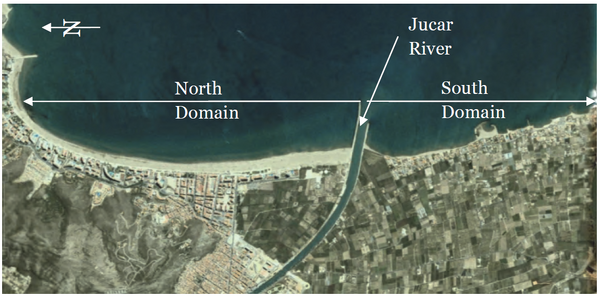
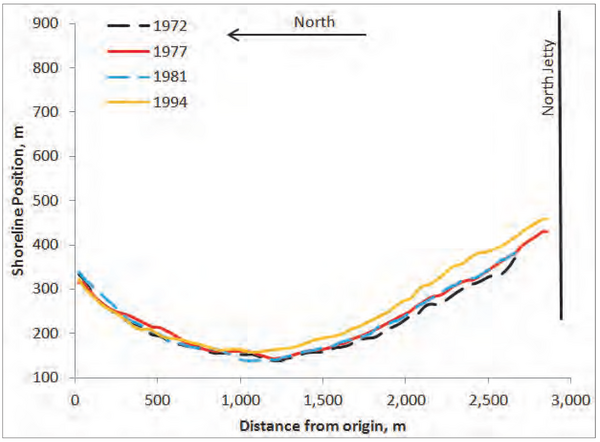
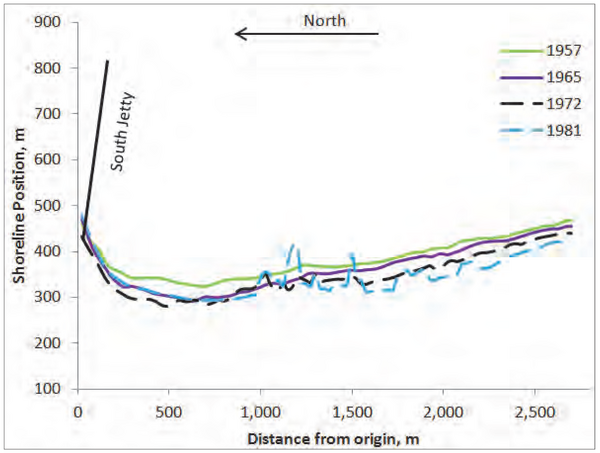
GENESIS Results
GENESIS results, excerpted from Gravens (1997), are plotted in Figures 4 – 7 for comparison to GenCade. North domain model results (Figures 4 – 5) show shoreline advance except for a region about 2,000 m north of the jetty, following the general trends observed in the measured shorelines. GENESIS results fit observations less well for the southern domain (Figure 6). The model over predicts retreat near the jetty and predicts advance further south where the observed shoreline retreated. Observations available to verify model performance over the south domain include construction of groins and revetments, complicating shoreline response and modeling.
Calculated average net transport for the north domain during the calibration period was 61,900 m3/year to the south with gross transport of 90,000 m3/year. Calculated average net transport for the south domain during the calibration period was 59,300 m3/year to the south with gross transport of 98,000 m3/year. Calculated rates over both domains match the target budget well.
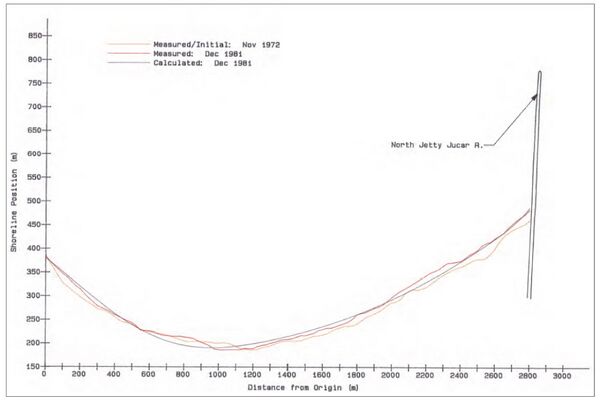
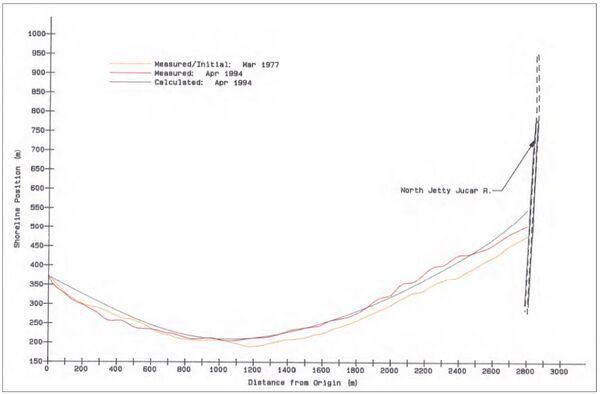
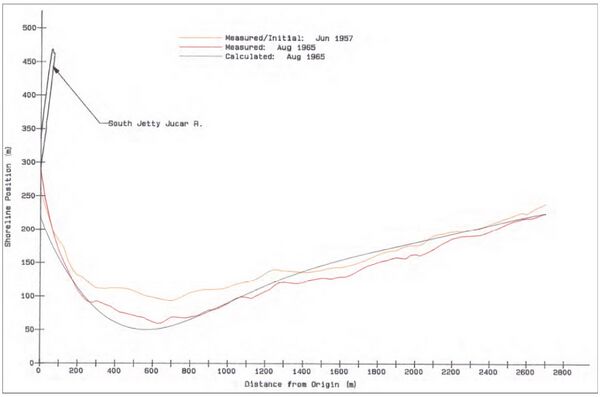
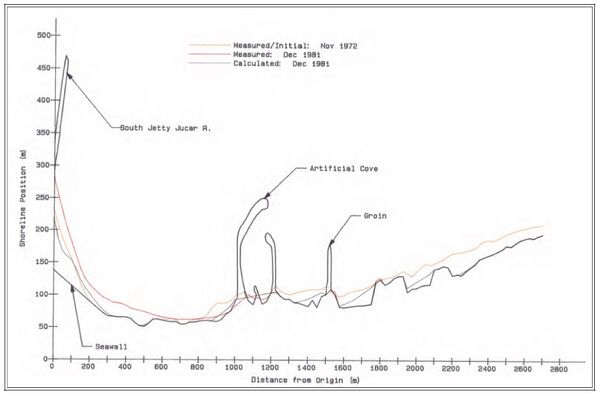
GenCade Model Setup and Parameters
Model Domain
Two model domains were developed. The beaches to the north of the jetties at Jucar River, Playa de San Antonio and Playa del Reco, comprise the north domain. Playa del Marenyet and Playa de Estany beaches, south of the jetties, comprise the southern domain (domain locations labeled in Figure 1). Both domains used the jetties as one boundary. The northern end of the north domain was pinned and the southern end of the south domain was specified with measured shoreline change. A constant cell size of 25 m was applied. Figure 8 shows the northern domain. Figure 9 shows the southern domain. Table 1 lists common input data applied.
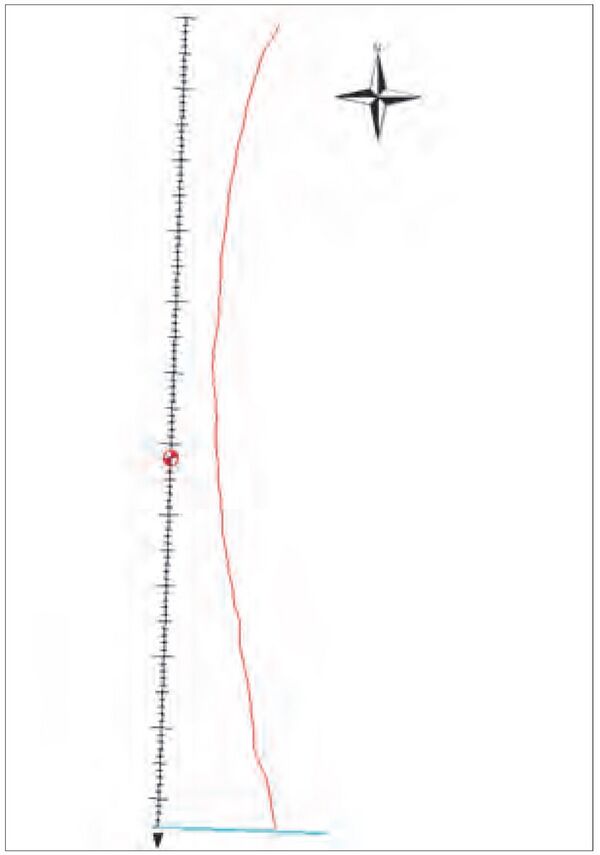


Model Forcing: Waves
Statistical wave data based on ship board observations analyzed by ALATEC S.A. in November 1996 were applied in Gravens (1997). The data were binned in seven heights and 16 directions and organized in 6-hour time steps to represent a typical year. Data applied in Gravens (1997) was applied in GenCade to enable consistent comparison between model results. Wave observations are assumed to be at the 20 m depth contour.
Model Parameters
Various parameters were adjusted to calibrate GenCade. Table 2 lists the best fit values for each domain.

GenCade Model Results and Discussion
North Domain
K1 and K2 were initially varied to match the target sediment budget, and then modified to improve the shoreline change predictions. Table 3 shows the GenCade calculated transport rates. Similar values for K1 and K2 were required to match observed shoreline change observed. Calculated transport was higher than GENESIS calculated transport rates which were lower than estimated transport rates.
